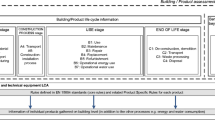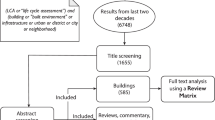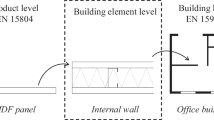Abstract
Although life cycle assessment (LCA) is intensively employed in the residential building sector, the incompleteness problem threatens the reliability of LCA. Considering the incompleteness of LCA studies, this study aims at developing a new calculation tool by evaluating an index of completeness (IoC) of LCA on residential buildings. An in-depth review on the existing LCA studies is conducted, and the frequently involved processes/materials are identified and listed. The calculation tool, IoC-Res, is subsequently developed, enclosing all the processes/materials in the checklist. IoC-Res can evaluate the completeness of the entire life cycle stages of a residential building, giving results for six impact categories. Case studies are conducted with the evaluation of IoCs for six building cases using IoC-Res. The results demonstrate that IoCs can be significantly different among impact categories. High IoCs are found in the impact categories such as climate change and particulate matter, while low IoCs are observed in eutrophication and metal depletion. The developed IoC-Res can provide a quantitative evaluation on the completeness of LCA of residential buildings and hence helps to guarantee the study quality and ultimately improve the reliability of LCA.
Graphic abstract
















Similar content being viewed by others
References
Abd Rashid AF, Idris J, Yusoff S (2017) Environmental impact analysis on residential building in malaysia using life cycle assessment. Sustainability 9(3):329
Ali AAMM, Negm AM, Bady MF, Ibrahim MG (2015) Environmental life cycle assessment of a residential building in Egypt: A case study. Procedia Technol 19:349–356
Aye L, Ngo T, Crawford RH, Gammampila R, Mendis P (2012) Life cycle greenhouse gas emissions and energy analysis of prefabricated reusable building modules. Energy and Buildings 47:159–168
Bahramian M, Yetilmezsoy K (2020) Life cycle assessment of the building industry: An overview of two decades of research (1995–2018). Energy and Buildings 219:109917
Buyle M, Braet J, Audenaert A (2014) Life cycle assessment of an apartment building: comparison of an attributional and consequential approach. Energy Procedia 62:132–140
Chastas P, Theodosiou T, Kontoleon KJ, Bikas D (2018) Normalising and assessing carbon emissions in the building sector: A review on the embodied CO2 emissions of residential buildings. Build Environ 130:212–226
Crawford, R. (2012). An as-occupied life cycle energy assessment of a residential building. In Proceedings of the 46th Annual Conference of the Architectural Science Association, November, 2012, Gold Coast, Australia
CSN (2011). Sustainability of Construction Works—Assessment of Environmental Performance of Buildings—Calculation Method. EN15978. European Standards. Brussels, Belgium
Cuéllar-Franca RM, Azapagic A (2012) Environmental impacts of the UK residential sector: life cycle assessment of houses. Build Environ 54:86–99
De Boeck L, Verbeke S, Audenaert A, De Mesmaeker L (2015) Improving the energy performance of residential buildings: a literature review. Renew Sustain Energy Rev 52:960–975
Dong YH, Ng ST (2015) A life cycle assessment model for evaluating the environmental impacts of building construction in Hong Kong. Build Environ 89:183–191
Dong Y, Liu P, Hossain MU, Fang Y, He Y, Li H (2021) An Index of Completeness (IoC) of life cycle assessment: implementation in the building sector. J Clean Prod 283:124672
Durlinger B, Crossin E, Wong J (2013) Life cycle assessment of a cross laminated timber building. Forest and Wood Product, Melbourne
Fesanghary M, Asadi S, Geem ZW (2012) Design of low-emission and energy-efficient residential buildings using a multi-objective optimization algorithm. Build Environ 49:245–250
Geng S, Wang Y, Zuo J, Zhou Z, Du H, Mao G (2017) Building life cycle assessment research: a review by bibliometric analysis. Renew Sustain Energy Rev 76:176–184
Gustavsson L, Joelsson A (2010) Life cycle primary energy analysis of residential buildings. Energy Build 42(2):210–220
Hu M (2019) Building impact assessment—a combined life cycle assessment and multi-criteria decision analysis framework. Resour Conserv Recycl 150:104410
Huijbregts MAJ, Steinmann ZJN, Elshout PMF, Stam G, Verones F, Vieira MDM, Van Zelm R (2016) ReCiPe 2016: a harmonized life cycle impact assessment method at midpoint and endpoint level Report I: Characterization: 2016. RIVM Report 2016–0104. National Institute for Human Health and the Environment, Bilthoven, The Netherlands
Huo T, Ren H, Cai W (2019) Estimating urban residential building-related energy consumption and energy intensity in China based on improved building stock turnover model. Sci Total Environ 650:427–437
Ingrao C, Messineo A, Beltramo R, Yigitcanlar T, Ioppolo G (2018) How can life cycle thinking support sustainability of buildings? Investigating life cycle assessment applications for energy efficiency and environmental performance. J Clean Prod 201:556–569
Islam H, Jollands M, Setunge S (2015) Life cycle assessment and life cycle cost implication of residential buildings—a review. Renew Sustain Energy Rev 42:129–140
ISO (2006a). Environmental Management: Life Cycle Assessment—Principles and Framework. ISO 14040:2006. International Organization for Standardization (ISO), Geneva, Switzerland
ISO (2006b). Environmental management: Life cycle assessment—requirements and guidelines. ISO 14044: 2006. International Organization for Standardization (ISO), Geneva, Switzerland
Kamali M, Hewage K, Sadiq R (2019) Conventional versus modular construction methods: a comparative cradle-to-gate LCA for residential buildings. Energy and Buildings 204:109479
Kumanayake R, Luo H (2018) Life cycle carbon emission assessment of a multi-purpose university building: a case study of Sri Lanka. Front Eng Manag 5(3):381–393
Kylili A, Ilic M, Fokaides PA (2017) Whole-building Life Cycle Assessment (LCA) of a passive house of the sub-tropical climatic zone. Resour Conserv Recycl 116:169–177
Lee S, Tae S, Roh S, Kim T (2015) Green template for life cycle assessment of buildings based on building information modeling: Focus on embodied environmental impact. Sustainability 7(12):16498–16512
Ma M, Cai W, Wu Y (2019) China act on the energy efficiency of civil buildings (2008): a decade review. Sci Total Environ 651:42–60
Nwodo MN, Anumba CJ (2019) A review of life cycle assessment of buildings using a systematic approach. Build Environ 162:106290
Omar WMSW (2018) A hybrid life cycle assessment of embodied energy and carbon emissions from conventional and industrialised building systems in Malaysia. Energy Build 167:253–268
Pablo-Romero MDP, Pozo-Barajas R, Yñiguez R (2017) Global changes in residential energy consumption. Energy Policy 101:342–352
Pajchrowski G, Noskowiak A, Lewandowska A, Strykowski W (2014) Wood as a building material in the light of environmental assessment of full life cycle of four buildings. Constr Build Mater 52:428–436
Paleari M, Lavagna M, Campioli A (2016) The assessment of the relevance of building components and life phases for the environmental profile of nearly zero-energy buildings: life cycle assessment of a multifamily building in Italy. Int J Life Cycle Assess 21(12):1667–1690
Pinky L, Reddy SM, Palaniappan S (2012) Application of life cycle assessment for a residential building construction. International Symposium on Life Cycle Assessment and Construction, July 10–12, Nantes, France
Pombo O, Allacker K, Rivela B, Neila J (2016) Sustainability assessment of energy saving measures: a multi-criteria approach for residential buildings retrofitting—a case study of the Spanish housing stock. Energy and Buildings 116:384–394
Pöyry A, Säynäjoki A, Heinonen J, Junnonen JM, Junnila S (2015) Embodied and construction phase greenhouse gas emissions of a low-energy residential building. Procedia Econ Finance 21:355–365
Rasmussen FN, Ganassali S, Zimmermann RK, Lavagna M, Campioli A, Birgisdóttir H (2019) LCA benchmarks for residential buildings in Northern Italy and Denmark–learnings from comparing two different contexts. Build Res Inf 47(7):833–849
Resene (2021). Resene Paints Ltd. http://www.resene.co.nz. Accessed on 1 March 2021
Ristimäki M, Säynäjoki A, Heinonen J, Junnila S (2013) Combining life cycle costing and life cycle assessment for an analysis of a new residential district energy system design. Energy 63:168–179
Röck M, Saade MRM, Balouktsi M, Rasmussen FN, Birgisdottir H, Frischknecht R et al (2020) Embodied GHG emissions of buildings–The hidden challenge for effective climate change mitigation. Appl Energy 258:114107
Roh S, Tae S (2017) An integrated assessment system for managing life cycle CO2 emissions of a building. Renew Sustain Energy Rev 73:265–275
Säynäjoki A, Heinonen J, Junnila S, Horvath A (2017) Can life-cycle assessment produce reliable policy guidelines in the building sector? Environ Res Lett 12(1):013001
Sim J, Sim J (2016) The air emission assessment of a South Korean traditional building during its life cycle. Build Environ 105:283–294
Vitale P, Arena N, Di Gregorio F, Arena U (2017) Life cycle assessment of the end-of-life phase of a residential building. Waste Manag 60:311–321
Wen TJ, Siong HC, Noor ZZ (2015) Assessment of embodied energy and global warming potential of building construction using life cycle analysis approach: case studies of residential buildings in Iskandar Malaysia. Energy Build 93:295–302
Wrålsen B, O’Born R, Skaar C (2018) Life cycle assessment of an ambitious renovation of a Norwegian apartment building to nZEB standard. Energy Build 177:197–206
Yang X, Hu M, Wu J, Zhao B (2018) Building-information-modeling enabled life cycle assessment, a case study on carbon footprint accounting for a residential building in China. J Clean Prod 183:729–743
Yu D, Tan H, Ruan Y (2011) A future bamboo-structure residential building prototype in China: life cycle assessment of energy use and carbon emission. Energy Build 43(10):2638–2646
Zhang W, Tan S, Lei Y, Wang S (2014) Life cycle assessment of a single-family residential building in Canada: a case study. Build Simul 7(4):429–438
Zhang W, Yang S, Liu Y (2019) From well-off housing to integrated housing-40 years housing construction brief introduction of china national engineering, research center for human settlements. Constr Sci Technol 18(10):57–60 (in Chinese)
Zygomalas I, Baniotopoulos C (2014) Life cycle assessment environmental data for structural steel construction in Greece. Int J Sustain Eng 7(1):13–23
Acknowledgements
This study is supported by the Startup Funding of Qingdao University of Science and Technology (Grant No. 010029060). We are grateful to the anonymous reviewers and the editor for the constructive comments in the process of improving this paper.
Funding
This study is supported by the start-up funding of Qingdao University of Science and Technology (Grant No. 010029060).
Author information
Authors and Affiliations
Contributions
Dong, Yahong contributed to conceptualization, methodology, software, writing—original draft, writing—review and editing, and funding acquisition; Liu, Peng was involved in validation, writing—original draft, writing—review and editing, and resources.
Corresponding author
Ethics declarations
Conflict of interest
Not applicable.
Additional information
Publisher's Note
Springer Nature remains neutral with regard to jurisdictional claims in published maps and institutional affiliations.
Supplementary Information
Below is the link to the electronic supplementary material.
Rights and permissions
About this article
Cite this article
Dong, Y., Liu, P. Evaluation of the completeness of LCA studies for residential buildings. Clean Techn Environ Policy 24, 229–250 (2022). https://doi.org/10.1007/s10098-021-02115-x
Received:
Accepted:
Published:
Issue Date:
DOI: https://doi.org/10.1007/s10098-021-02115-x




